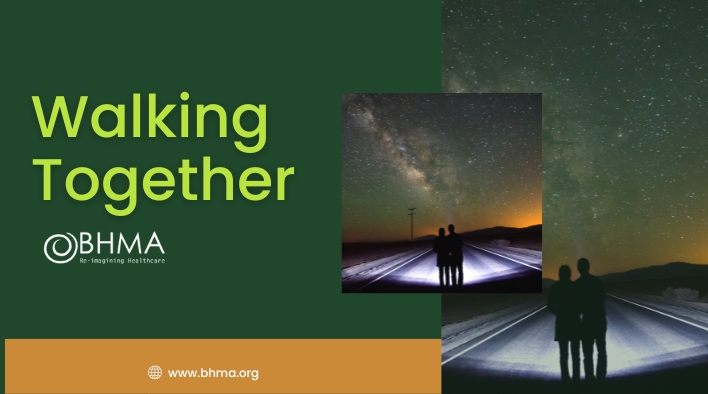Walking together
Published in JHH18.1 – Flourishing in Medical Education
Harris Nageswaran, Medical student, Barts and The London School of Medicine and Dentistry
Hester Toovey, Medical student, Barts and The London School of Medicine and Dentistry
Grace Catchpole, Medical student, Barts and The London School of Medicine and Dentistry
My journey through medical school has perhaps been characterised just as much by the extracurricular experiences I’ve sought as the curricular experiences alone. I’ve slowly found my own voice in medicine through the people around me, as well as through representing and advocating for changes as a student rep.
I am a fourth year medical student at Barts and The London. Taking part in the lockdown creative enquiry project ‘Interpretive Voices’ helped me to see the value in exploring our lived experiences using art. Using artistic mediums has allowed me to be vulnerable and share personal experiences at medical school without feeling exposed.
I am a final year medical student whose interests are in medical education, understanding suffering, and the effect on healthcare of implicit bias. I have previously spoken on a panel about mental health and the arts, and at various conferences about the role of arts in medical education. Being part of this creative piece helped me look back over my time at medical school and appreciate how far I’ve come and how important creative outlets have been for me.
The three of us were inspired to collaborate on creating something that would show our experiences of flourishing at medical school in a way that we have not been able to before, in a safe space we could create between us. A collaborative piece appealed to us all but it brought its own anxieties: displaying perceived ‘weaknesses’ is difficult for us medical students! To explore them in such depth was intimidating and left us feeling vulnerable and fearful of being judged.
First we created our personal mind map of our time at medical school. The mind maps allowed some self[1]reflection and helped set boundaries around our discussion and allayed some of our initial anxieties. We all had mixed feelings while completing our maps: a sense of distance from ‘past versions’ of ourselves which reflected the rapid maturation and personal growth we had undergone since starting at medical school as teenagers. Our process of reflection was extremely emotional at times, when revisiting events that were painful to recollect and explore. Finally, there was a struggle to decide what went on to the page. It was difficult not to self-edit and decide what parts of our experiences should be given significance. We found ourselves thinking about how other people’s suffering affected our ability to flourish, but it was difficult to decide how much we could talk about those experiences in detail. They did not seem like our stories to tell, even though we felt it important to take ownership of all that had influenced our personal journeys.
Once our mind maps were complete, we came together to interview each other about their contents. Taking the rotating role of interviewee, interviewer, or scribe gave us a sense of shared experience and shared pain and meant having to remain highly focused for the whole session. Many of the experiences we explored in our interviews were intense or emotionally charged. As we cycled through different ways of meaning-making and connection in the different roles the session became physically and mentally exhausting. Although we had assumed our experiences would be starkly different, there were many common threads which added to our sense of connection, helping us feel we could stay honest throughout the process. The role of scribe was the most difficult one: the pressure to document someone’s story well enough to honour their experiences. After the call, which lasted for five hours, all of us noticed a change – feeling lighter having shared personal struggles and, over the following days, more reflective about ourselves and our medical school journey.
Our discussions made us realise how our stories aligned more than they differed. So we were inspired to create a piece to celebrate our personal journeys but also that would highlight our common experiences. Being aware that our artistic styles were very different, it was quite a challenge to bring our styles together cohesively. Eventually we settled on the metaphors of journeys, their paths and threads. Our joint piece took shape on a mood board of images around these themes, each of us creating individual paths to reflect our medical school journey. Having mapped out our own paths, with their contours, tributaries, twists and turns, we made collaborative artistic pieces at key moments of intersection. One person would start the image and send it to someone else to complete. These embedded pieces are: the eye reflecting a person crying, which depicts our shared struggle with being a witness to others’ suffering; a comic-book style ‘no’ telling how learning to set boundaries was a turning point; a group of people where there is a clear ‘odd one out’ reflects our tussles with imposter syndrome. We chose hands as a repeating motif to unify our individual journeys, poignant moments of reaching out for help or of being reached out to which had got us through our time at medical school. After creating the piece, we talked of our feelings about it. The process of committing our journeys to paper had allowed us to recognise and reflect on difficult experiences without the initial intensity of emotion. Seeing everything on one page helped us realise how we had been able to flourish despite adversity. In the piece we sensed optimism, and creating it together had helped us see that things can be shared deeply even without words. Through art and conversation we found a different voice, one that has both nourished our relationship and shed light on how we can flourish as we move forward individually and together.







